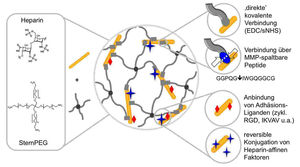The important successes in implantation and transplantation medicine achieved in the last years have their base mainly on expanding of experimental knowledge.
The TRR 67 intends to change this situation completely through the basic research oriented investigation and development of glycosaminoglycan based artificial extracellular matrices (aECM) for wound healing in skin and bone injuries. The TRR 67 focuses on acquiring knowledge about the significance of the ECM for the differentiation of cells and tissue regeneration und aims to develop biomaterials based on this findings. Target is to develop biomaterials that interact with effector molecules to control the cell response during the healing process.
The proposed sub-project concerns the design, characterization and application of a set of novel biohybrid polymer hydrogels that consist of naturally occurring glycosaminoglycans connected by different crosslinking schemes with or without incorporation of functional (MMP-cleavable and or selfassembling) peptides in varying degrees of crosslinking.
Extending previous related work on pro-angiogenic starPEG-heparin hydrogels the material platform will be applied to stimulate recruitment, ingrowth and morphogenesis of endothelial- and endothelial progenitor cells to result in angiogenesis, to activate macrophages and to support the chemotactic migration and differentiation of dermal fibroblasts.
The project is outlined as a close collaboration with Professor Jan-Christoph Simon and Professor Annette Beck-Sickinger, Leipzig University.


